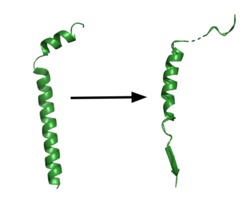Sandbox Reserved 1619
From Proteopedia
(Difference between revisions)
| Line 7: | Line 7: | ||
===Background=== | ===Background=== | ||
| - | Gamma Secretase (GS) is a transmembrane [https://en.wikipedia.org/wiki/Aspartic_protease aspartatic protease]. It catalyzes peptide bond hydrolysis of type I integral membrane proteins such as Notch, amyloid precursor protein (APP), and various other substrates. It recognizes and catalyzes the reaction with its substrate using 3 residue segments. These | + | Gamma Secretase (GS) is a transmembrane [https://en.wikipedia.org/wiki/Aspartic_protease aspartatic protease]. It catalyzes peptide bond hydrolysis of type I integral membrane proteins such as Notch, amyloid precursor protein (APP), and various other substrates. It recognizes and catalyzes the reaction with its substrate using 3 residue segments. These 3 residue segments give rise to specific cleavage points for each substrate. APP is the primary substrate of focus, and it is cleaved to form amyloid-β peptides(Aβ). This product is important for various neural processes, and it is well known for its implications with [https://en.wikipedia.org/wiki/Alzheimer%27s_disease Alzheimer's disease (AD).] This has made GS a popular drug target, specifically using gamma secretase inhibitors. However, due to the nature of the enzyme having various neural functions, there are dangerous side effects when it is inhibited. |
===Overall Structure=== | ===Overall Structure=== | ||
| Line 24: | Line 24: | ||
===Lid Complex=== | ===Lid Complex=== | ||
| - | The <scene name='83/832945/Lidremake/1'>lid complex</scene> is the first point of entry and recognition for the substrate. This lid is located within the NCT subunit between Asn55 and Asn435. This lobe of NCT is divided into two separate subunits, being the large and small lobes. Phe287 from the large lobe acts as pivot between them. This <scene name='83/832945/Pivot/1'>Phe is further surrounded by Phe103, Leu171, Phe176, and Ile180</scene> of the small subunit, and these residues compose a greasy pocket for that provides an environment for easy movement. The lid consists of 5 aromatic residues which are highly involved with stabilizing the closed conformation. In particular, this conformation is stabilized by <scene name='83/832945/Trp164scene/1'>Trp164, which interacts with Pro424, Phe448, and the aliphatic side chain of Gln420</scene>. Once the substrate binds and the lid is opened, a charged, hydrophilic pocket is revealed. This pocket contains <scene name='83/832945/Gluandtyr_remake/1'>Glu333 and Tyr337 surrounded by several charged residues</scene>, and is further involved with substrate binding and recognition once the lid is removed<ref name="Bai">PMID:26280335</ref> . | + | The <scene name='83/832945/Lidremake/1'>lid complex</scene> is the first point of entry and recognition for the substrate. This lid is located within the NCT subunit between Asn55 and Asn435. This lobe of NCT is divided into two separate subunits, being the large and small lobes. Phe287 from the large lobe acts as pivot between them. This <scene name='83/832945/Pivot/1'>Phe is further surrounded by Phe103, Leu171, Phe176, and Ile180</scene> of the small subunit, and these residues compose a greasy pocket for that provides an environment for easy movement. The lid consists of 5 aromatic residues which are highly involved with stabilizing the closed conformation. In particular, this conformation is stabilized by <scene name='83/832945/Trp164scene/1'>Trp164, which interacts with Pro424, Phe448, and the aliphatic side chain of Gln420</scene>. Once the substrate binds and the lid is opened, a charged, hydrophilic pocket is revealed. This pocket contains <scene name='83/832945/Gluandtyr_remake/1'>Glu333 and Tyr337 surrounded by several charged residues</scene>, and is further involved with substrate binding and recognition once the lid is removed. However, this lid complex is relatively far away from the catalytic site of the enzyme. Once the substrate binds, the enzyme undergoes a conformational change to shorten this distance, and the rotation of the large lobe in relation to the small lobe reorients the substrate for cleavage by aligning the pocket in NCT to the active site in PS1 <ref name="Bai">PMID:26280335</ref>. |
| - | + | ||
Revision as of 22:32, 20 April 2020
Gamma Secretase
| |||||||||||
References
- ↑ 1.0 1.1 Yang G, Zhou R, Shi Y. Cryo-EM structures of human gamma-secretase. Curr Opin Struct Biol. 2017 Oct;46:55-64. doi: 10.1016/j.sbi.2017.05.013. Epub, 2017 Jul 17. PMID:28628788 doi:http://dx.doi.org/10.1016/j.sbi.2017.05.013
- ↑ 2.0 2.1 2.2 Zhou R, Yang G, Guo X, Zhou Q, Lei J, Shi Y. Recognition of the amyloid precursor protein by human gamma-secretase. Science. 2019 Feb 15;363(6428). pii: science.aaw0930. doi:, 10.1126/science.aaw0930. Epub 2019 Jan 10. PMID:30630874 doi:http://dx.doi.org/10.1126/science.aaw0930
- ↑ 3.0 3.1 Bai XC, Yan C, Yang G, Lu P, Ma D, Sun L, Zhou R, Scheres SH, Shi Y. An atomic structure of human gamma-secretase. Nature. 2015 Aug 17. doi: 10.1038/nature14892. PMID:26280335 doi:http://dx.doi.org/10.1038/nature14892
- ↑ Bolduc DM, Montagna DR, Seghers MC, Wolfe MS, Selkoe DJ. The amyloid-beta forming tripeptide cleavage mechanism of gamma-secretase. Elife. 2016 Aug 31;5. doi: 10.7554/eLife.17578. PMID:27580372 doi:http://dx.doi.org/10.7554/eLife.17578
- ↑ Kumar D, Ganeshpurkar A, Kumar D, Modi G, Gupta SK, Singh SK. Secretase inhibitors for the treatment of Alzheimer's disease: Long road ahead. Eur J Med Chem. 2018 Mar 25;148:436-452. doi: 10.1016/j.ejmech.2018.02.035. Epub , 2018 Feb 15. PMID:29477076 doi:http://dx.doi.org/10.1016/j.ejmech.2018.02.035
Student Contributors
Layla Wisser
Daniel Mulawa

